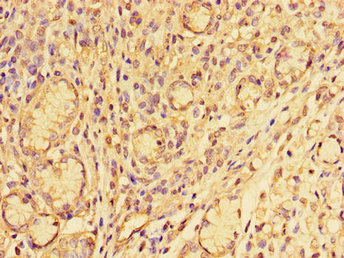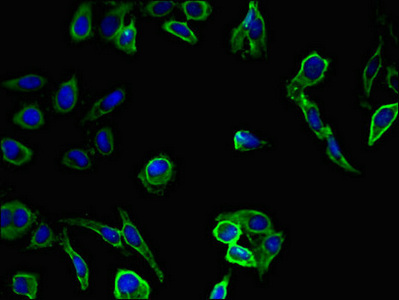SNAI2 Antibody
-
中文名称:SNAI2兔多克隆抗体
-
货号:CSB-PA021869LA01HU
-
规格:¥440
-
促销:
-
图片:
-
其他:
产品详情
-
产品名称:Rabbit anti-Homo sapiens (Human) SNAI2 Polyclonal antibody
-
Uniprot No.:O43623
-
基因名:
-
别名:MGC10182 antibody; Neural crest transcription factor Slug antibody; Protein snail homolog 2 antibody; Slug (chicken homolog) zinc finger protein antibody; Slug homolog zinc finger protein antibody; Slug zinc finger protein antibody; SLUGH antibody; SLUGH 1 antibody; SLUGH1 antibody; SNAI 2 antibody; Snai2 antibody; SNAI2_HUMAN antibody; Snail 2 antibody; Snail homolog 2 antibody; Snail2 antibody; WS 2D antibody; WS2D antibody; Zinc finger protein SLUG antibody; Zinc finger protein SNAI2 antibody
-
宿主:Rabbit
-
反应种属:Human
-
免疫原:Recombinant Human Zinc finger protein SNAI2 protein (12-124AA)
-
免疫原种属:Homo sapiens (Human)
-
标记方式:Non-conjugated
本页面中的产品,SNAI2 Antibody (CSB-PA021869LA01HU),的标记方式是Non-conjugated。对于SNAI2 Antibody,我们还提供其他标记。见下表:
-
克隆类型:Polyclonal
-
抗体亚型:IgG
-
纯化方式:>95%, Protein G purified
-
浓度:It differs from different batches. Please contact us to confirm it.
-
保存缓冲液:Preservative: 0.03% Proclin 300
Constituents: 50% Glycerol, 0.01M PBS, PH 7.4 -
产品提供形式:Liquid
-
应用范围:ELISA, IHC, IF
-
推荐稀释比:
Application Recommended Dilution IHC 1:20-1:200 IF 1:50-1:200 -
Protocols:
-
储存条件:Upon receipt, store at -20°C or -80°C. Avoid repeated freeze.
-
货期:Basically, we can dispatch the products out in 1-3 working days after receiving your orders. Delivery time maybe differs from different purchasing way or location, please kindly consult your local distributors for specific delivery time.
相关产品
靶点详情
-
功能:Transcriptional repressor that modulates both activator-dependent and basal transcription. Involved in the generation and migration of neural crest cells. Plays a role in mediating RAF1-induced transcriptional repression of the TJ protein, occludin (OCLN) and subsequent oncogenic transformation of epithelial cells. Represses BRCA2 expression by binding to its E2-box-containing silencer and recruiting CTBP1 and HDAC1 in breast cells. In epidermal keratinocytes, binds to the E-box in ITGA3 promoter and represses its transcription. Involved in the regulation of ITGB1 and ITGB4 expression and cell adhesion and proliferation in epidermal keratinocytes. Binds to E-box2 domain of BSG and activates its expression during TGFB1-induced epithelial-mesenchymal transition (EMT) in hepatocytes. Represses E-Cadherin/CDH1 transcription via E-box elements. Involved in osteoblast maturation. Binds to RUNX2 and SOC9 promoters and may act as a positive and negative transcription regulator, respectively, in osteoblasts. Binds to CXCL12 promoter via E-box regions in mesenchymal stem cells and osteoblasts. Plays an essential role in TWIST1-induced EMT and its ability to promote invasion and metastasis.
-
基因功能参考文献:
- The relationships between the decreased methylation levels of the SNAI2 and ADAM23 genes and cancer de-differentiation and haematogenous dissemination, respectively, indicate novel functions of those genes in the invasive processes. PMID: 30189837
- inhibition of HDACs in triple-negative breast cancer cells may lead to inversion of EMT and the decrease of invasiveness by down-regulating the gene expression of Slug. Since EMT is known as a pre-metastatic process, triple-negative breast tumors, the EMT reversal effects of HDACs inhibition may reduce tumor cell metastasis. PMID: 29989579
- Data suggest that HOP homeobox HOPX (HOPX) acts as a tumour suppressor via the epigenetic regulation of snail family transcription factors (SNAIL) transcription and a prognostic biomarker for nasopharyngeal carcinoma (NPC) metastasis and therapeutic target for NPC treatment. PMID: 28146149
- By using a genome wide siRNA screen for deubiquitinating enzymes, we identified USP10 as a deubiquitinase for Slug in cancer cells. USP10 interacts with Slug and mediates its degradation by the proteasome. Importantly, USP10 is concomitantly highly expressed with Slug in cancer biopsies. PMID: 29803676
- ITGB4 plays a tumorigenic and pro-metastatic role mediated by Slug PMID: 28084395
- Daxx directly binds to the DNA-binding domain of Slug, impeding histone deacetylase 1 (HDAC1) recruitment and antagonizing Slug E-box binding. This, in turn, stimulates E-cadherin and occludin expression and suppresses Slug-mediated epithelial-mesenchymal transition (EMT) and cell invasiveness. PMID: 28004751
- our findings demonstrated that tumor cells may promote AEC II transdifferentiation. Furthermore, the transdifferentiation of AEC IIs may, in turn, induce the reactivation of 3D-established DTCs by promoting TGF-beta1/SNAI2 signaling PMID: 29436661
- High expression of Slug in gastric cancer tissue was associated with lymph node metastasis and poor survival. Evaluation of Slug would be useful for discriminating patients at high risk of lymph node metastasis in early gastric cancer. PMID: 28974196
- Collectively, our findings strongly suggest targeting miR-155 exhibited in vivo and in vitro antileukemic activities in acute myelogeneous leukemia through a novel mechanism resulting in inhibition of Slug expression and increase of PUMA expression. PMID: 27786352
- Slug-upregulated miR-221 promotes breast cancer progression via reducing E-cadherin expression. PMID: 27174021
- FBXO31 targets and ubiquitylates Slug for proteasomal degradation. However, this mechanism is repressed in breast tumors where miR-93 and miR-106a are overexpressed. Our study further unravels an interesting mechanism whereby Slug drives the expression of miR-93 and miR-106a, thus establishing a positive feedback loop to maintain an invasive phenotype PMID: 28500896
- Knockdown of Slug enhanced the antitumor activity of DOX in SW1736 cells via induction of PUMA upregulation. Our results suggest that targeting of Slug has good potential for the development of new therapeutic strategies for Anaplastic thyroid carcinoma. PMID: 28128736
- The data suggest that reduced expression of E-cadherin and over-expression of Slug, Snail, and TGF-beta induce epithelial to mesenchymal transition in ameloblastoma. PMID: 27995335
- miR-203/ERK1/2/Slug/E-cadherin signaling pathway plays an essential role on SGC7901 cell invasion and motility. miR-203 can be novel modalities to prevent peritoneal metastasis of invasive cancers such as gastric cancer. PMID: 28269747
- Review/Meta-analysis: SNAI2 promotes lymphovascular spread of ovarian cancer. PMID: 28039463
- TMPRSS4 modulates both invasion and proliferation via Slug and cyclin D1, which is a previously unrecognized pathway that may regulate metastasis and cancer progression PMID: 27385093
- Low slug expression is associated with cervical cancer. PMID: 27036045
- Claudin-5 was shown to be regulated VEGFR2/PI3K-Akt dependently by VEGF and PI3K-Akt independently by histamine. Interleukin-8 was shown to downregulate claudin-5 by histamine. PMID: 27873103
- NatD-mediated acetylation of histone H4 serine 1 competes with phosphorylation by CK2alpha at the same residue, leading to the upregulation of Slug and lung cancer progression. PMID: 29030587
- IGF1R phosphorylates histone H3 at tyrosine 41 and has a role in inducing SNAI2 expression in a process that involves Brg1 chromatin remodeling protein PMID: 27275536
- Lnc-CC3 promoted migration and invasion in cervical cancer cells by increasing Slug expression; lnc-CC3 may be useful marker of metastases in cervical cancer PMID: 27223436
- Our findings provide new evidence that LOX regulates SNAI2 expression and that SNAI2-mediated TIMP4 secretion plays a role in cancer progression. PMID: 27029493
- DeltaNp63alpha (TP63) is co-expressed with FAT2 and Slug in patient tumors and the elevated expression of DeltaNp63alpha, FAT2 and Slug correlated with poor patient outcome. PMID: 27081041
- Data show that miR-30a could bind to the 3'-untranslted region of Slug mRNA and increased expression of claudins, a family of tight junction transmembrane proteins. PMID: 26918943
- targeting SIRT2 may be a rational strategy for diminishing Slug abundance and its associated malignant traits in basal-like breast cancer. PMID: 27783945
- The data confirmed that inhibited expression of slug extensively decreased the growth of tumor and microvessel density in vivo. Moreover, knockdown of slug can significantly reduce tumor angiogenesis of SKOV3 cells via ccn1/vascular endothelial growth factor. PMID: 27368877
- linc00261 acts a tumour suppressor in Gastric cancer by decreasing the stability of Slug proteins and suppressing epithelial-mesenchymal transition. PMID: 27878953
- In addition to its angiogenic action, VEGFA upregulates Sox2 to drive stem cell expansion, together with miR-452 loss and Slug upregulation, providing a novel mechanism whereby cancer stem cells acquire metastatic potential. PMID: 28504716
- Slug is a positive regulator, and Snail a negative regulator, of PLD2 expression. PMID: 26781944
- miR-137 is a Slug-induced miRNA that relays the pro-metastatic effects of Slug by targeting TFAP2C in non-small cell lung cancer cells. PMID: 28610956
- UCA1 overexpression promoted cell epithelial-mesenchymal transition (EMT) in hepatocellular carcinoma via effectively sponging to miR-203 and thereby activating the expression of transcription factor Snail2. PMID: 28271214
- High SLUG expression is associated with lung metastasis in ovarian cancer. PMID: 27524413
- overexpression of miR-218 in H1299 increased chemosensitivity of cells to cisplatin treatment through suppression of Slug and ZEB2. These findings highlight an important role of miR-218 in the regulation of EMT-related traits and metastasis of lung cancer in part by modulation of Slug/ZEB2 signaling, and provide a potential therapeutic strategy by targeting miR-218 in lung cancer. PMID: 28192397
- regulation of cancer stem cell via SLUG-SOX9 regulatory axis PMID: 26387547
- our current findings highlight how Slug functions as an important transcriptional repressor that finely regulates the SCF/c-Kit signaling pathway. PMID: 27451973
- we infer that Slug enhances MMP1 transcription via directly binding to the promoter region in breast cancer cells, which is a previously unrecognized mechanism in the development of multi-drug resistance. PMID: 28334049
- The findings demonstrate that miR-203a plays an essential role in keratinocyte proliferation and differentiation caused by extracellular calcium by targeting the SNAI2 and DeltaNp63 genes. PMID: 28754589
- Slug expression was higher in cyclosporine A (CsA)-induced gingival overgrowth specimens than in clinical healthy gingiva. In addition, knockdown of Slug significantly suppressed CsA-induced cell proliferation in human gingival fibroblasts (HGFs). Upregulation of Slug in HGFs stimulated by CsA may play an important role in the pathogenesis of CsA-induced gingival overgrowth. PMID: 27287534
- gastrointestinal stromal tumour (GIST) patients with high tumour SLUG expression have unfavourable recurrence-free survival. SLUG may mediate pro-survival signalling in GISTs. PMID: 28334729
- Slug emerges as a key transcription factor driving smooth muscle cell towards a proliferative phenotype. PMID: 27441378
- reduction of Alex3 correlates with the development of non-small cell lung cancer and predicts adverse clinical outcome of non-small cell lung cancer patients. The effect of Alex3 on inhibiting invasion and migration may attribute to upregulation of E-cadherin expression through AKT-Slug pathway inactivation. PMID: 28705116
- High SLUG expression is associated with ovarian Cancers. PMID: 27216178
- The finding of down-regulation of the miR-200 family and up-regulation of transcription repressors Snail and Slug supports the postulated role of epithelial-mesenchymal transition in the pathogenesis of fibrosis in inflammatory bowel diseases. PMID: 27113480
- the epithelial-mesenchymal transition-related transcription factor Twist1 cooperates with Slug to regulate EMT upon H2A.X Loss. PMID: 27315462
- results demonstrate that skeletal stem/stromal cell mobilize Snail/Slug-YAP/TAZ complexes to control stem cell function PMID: 27479603
- SNAI2 behaves as a tumor suppressor by inhibiting multidrug resistance via suppressing ABC transporter genes in HCC cells PMID: 27760172
- Slug expression was inhibited and E-cadherin expression was increased in the Slug siRNA-transfected anaplastic thyroid tumors. PMID: 28070118
- A high expression level of SLUG can be an indicator of recurrence and a therapeutic target for long-term remission in high-grade endometrial carcinomas PMID: 27003026
- Our results revealed that Slug siRNA transfection in combination with radiation increased the expression of PUMA, which contributed to radiosensitivity of oral squamous cell carcinoma cells PMID: 27277529
- Treatment of these cells with the dual-specificity tyrosine-kinase inhibitor lapatinib led to downregulation of epithelial-to-mesenchymal transition as indicated by lower levels of SNAI1 and SNAI2 transcripts, integrin AVB6, and matrix metalloproteinase 9 protein PMID: 28349782
显示更多
收起更多
-
相关疾病:Waardenburg syndrome 2D (WS2D); Piebald trait (PBT)
-
亚细胞定位:Nucleus. Cytoplasm. Note=Observed in discrete foci in interphase nuclei. These nuclear foci do not overlap with the nucleoli, the SP100 and the HP1 heterochromatin or the coiled body, suggesting SNAI2 is associated with active transcription or active splicing regions.
-
蛋白家族:Snail C2H2-type zinc-finger protein family
-
组织特异性:Expressed in most adult human tissues, including spleen, thymus, prostate, testis, ovary, small intestine, colon, heart, brain, placenta, lung, liver, skeletal muscle, kidney and pancreas. Not detected in peripheral blood leukocyte. Expressed in the dermi
-
数据库链接:
HGNC: 11094
OMIM: 172800
KEGG: hsa:6591
STRING: 9606.ENSP00000020945
UniGene: Hs.360174
Most popular with customers
-
-
YWHAB Recombinant Monoclonal Antibody
Applications: ELISA, WB, IF, FC
Species Reactivity: Human, Mouse, Rat
-
-
-
-
-
-























